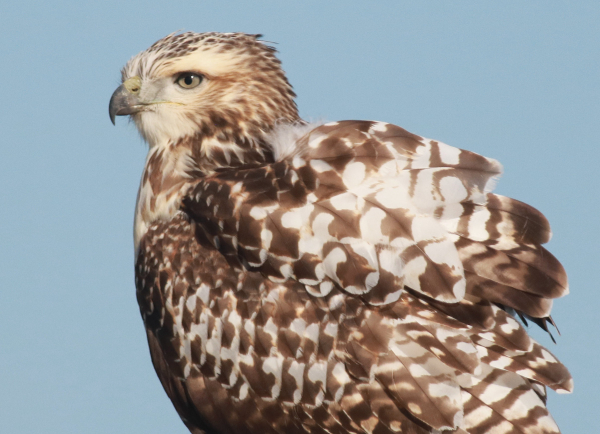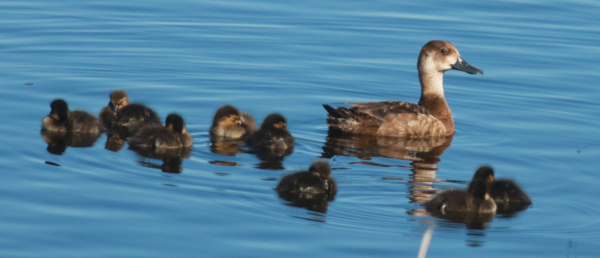
During a trusting encounter, a beautiful fledgling Red-tailed Hawk appears to be cooling itself by letting the wind flow beneath its back plumage.

A female Lesser Scaup keeps alert as her new brood of eight takes a duck nap on tranquil water. Just as the downy yellow Redhead ducklings are a treat to view, dark-brown scaup ducklings are equally attractive.

Hard to find this time of year in the thick grassland vegetation, this maturing fledgling Sharp-tailed Grouse was crossing a rural road with its brood led by the adult female.
|
As I rounded the curve just a mile south of my office I was surprised by an assemblage of hundreds of very vocal Franklin’s Gulls as they assembled in a shallow wetland. They were repositioning from a newly plowed ag field where many were still feeding. Many of the gulls were molting out of their alternate plumage, and scattered throughout the crowded flock were many recent fledglings. As impressive as this aggregation was, it only lasted a few hours, then all were gone.
Even so, several species are flocking together in post-nesting flocks, some of which add up to tens and hundreds of birds – Yellow-headed and Red-winged Blackbirds, Ring-billed Gulls, Tree and Bank Swallows, plus loose groups of American Coots, and molting ducks and geese that become flightless this time of summer. It’s all part of the changing seasons in the Northern Great Plains.
Tuesday afternoon I sighted the first newly hatched Lesser Scaup brood of this summer, sleeping on tranquil roadside pond with the hen keeping watch during duckling naptime. I was excited and at first I was unsure of whether this was indeed a scaup brood, or a Ring-necked Duck brood. Ring-neck ducklings are similar to Lesser Scaup, and female Ring-necks can resemble Scaup hens. There should be more scaup broods in coming days, along with a Ring-necked brood or two. Ruddy Duck broods continue to hatch almost daily, but the end of the hatching period is probably not far off for this summer’s impressive duck nesting season. Even so, broods continue to mature, and ever expand the population size of their respective species.
During my weekly stopover at McKenzie I spent some time with a Ruddy Duck hen and brood of 12, along with two neighboring Eared Grebe families – one very young, the other quite mature. It was especially interesting to witness one adult grebe that appeared to be teaching, or at least encouraging, its brood to practice running take-offs in advance of actually flying. I documented it via photos, and it was quite interesting to witness. I also saw individual soon-to-be fledgling Eared Grebes practicing on their own after the adult initiated the exercise. Grebes also use this running take-off behavior to move from location to location without actually taking flight, and to leave an area when pressed by another animal. Coots also relocate in this way, running atop the water.
Speaking of McKenzie, the best areas to photograph duck broods on the east and west sides of the vast marsh were dry, and the areas that were being used by Arctic-nesting shorebirds the past two weeks were likewise dry – and I didn’t see any shorebirds aside from a couple Killdeer. That’s normal for this time of the year, and it accents the difference between my neighborhood and areas 50 miles to the west, and beyond. It’s actually a simple matter of geography – the farther west you travel, the drier it gets; although it’s also a matter of where rain falls during a given season, or even during certain storm systems. Nonetheless, McKenzie Slough has been a super wetland area, and it is still just a good rainfall away from rejuvenating its attraction to shorebirds and more.
Local Yokels
Similarly, the two local rainwater puddles that attracted shorebirds – and me – quickly became abandoned dry mini-basins. During an extended drive Monday evening south of my office I was surprised to find an older Green-winged Teal brood that were very adult-looking. This was the first Green-wing brood I’ve seen this year, and there are few produced in the area – I only found one last year; Blue-wings are king here. I also found an older brood of Gadwalls, maybe three weeks old, but all of the Ruddy Duck broods I saw were less than a week old. And ducks weren’t the only broods that showed.
A nearly mature brood of Sharp-tailed Grouse and a 10-day old brood of Ring-necked Pheasants also appeared. It is always amazing to see such little pheasants fly, even a short distance, without hesitation. I saw Red-headed Woodpeckers at two of the four nest sites I checked, and I found the two big Bald Eagles fledglings are still hanging out near their nest. I also looked for two sets of Red-tailed Hawk fledglings Sunday and Monday, and it seems as though they are beginning to disperse during the end of their post-fledging period.
One of the Red-tails, a big female that fledged with two males from a nest just two miles south of home, has been especially trusting, allowing me to walk closer to its perch sites than I would expect. It’s fun to feel like I’ve developed a bit of a rapport with this impressive fledgling and I’m hoping her trust in me will pay off in the form of some nice portrait and flight photos soon. However, I share a first look at this fledgling in the somewhat unusual photo I took Sunday in which larger feathers on her back are being blown to one side, seemingly to allow fresh are to circulate under some plumage over an extended period.
At home, action at my feeding station has been lighter, although the same species continue to visit – except the Orchard Orioles, which are an obvious a big loss as the summer season progresses. The biggest surprise last week was the momentary appearance of a young Northern Flicker that I saw peeking around the tree trunk next to my feeders. The Blue Jay family is regular again, feeding on no-melt suet bits that fall to the ground and drinking fresh water. But Saturday I witnessed a breakthrough by a fledgling jay that began hanging by its feet from top of suet cage to feed on the no-melt suet cake upside down. Ruby-throated Hummingbirds continue to be spotty nectar fans most days, and the Hairy Woodpeckers continue to feed on no-melt suet daily, although Tuesday the first adult male Hairy visited the feeding station a couple times.
Enjoy these early days of August as you make the most of birding at your feeders, in your yard, and at your favorite birding locations – and don’t hesitate to check out a new location, just for fun.
Article and photos by Paul Konrad
Share your bird sightings and photos at editorstbw2@gmail.com